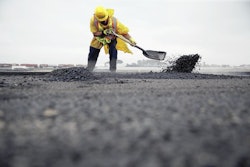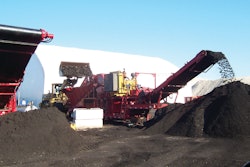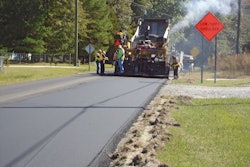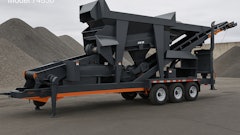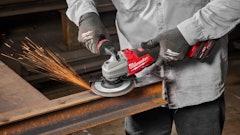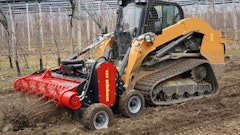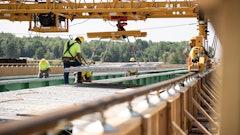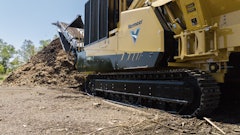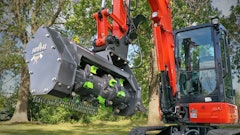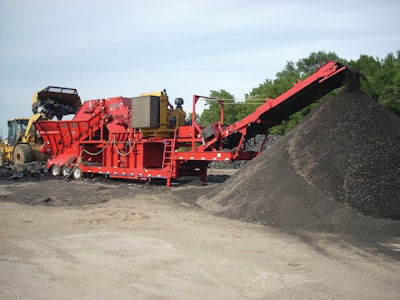
Asphalt shingle recycling is a growing market, which makes getting into this business very attractive to asphalt contractors and producers. Asphalt shingle waste continues to be one of the most valuable materials in the waste stream, and many want to take advantage of this new green paving technology.
According to Murray McIntyre, a regional sales manager with Rotochopper, there are several factors that determine the profitability of producing recycled asphalt shingles (RAS): wear costs, downtime associated with maintenance, uptime productivity, and particle control. "The correct selection of shingle processing equipment will ultimately define the bottom line profitability of a shingle recycling operation," he says.
So, where to begin when selecting a shingle grinder for your operation? There are three questions to consider. Should you buy a new or used machine? What features should you look for? And what wear items are crucial to keeping your machine producing?
Should you buy new or used?
The price point of a machine is always a critical factor when buying equipment. McIntyre stresses that a used machine – while offering a lower purchasing price – may end up costing more in the end.
"While it's truly tempting to try cutting corners in the beginning, fixating on the lower initial capital cost of a used wood grinder, a few weeks of uninterrupted grinding versus the maintenance issues you are very likely going to experience from the start with a typical used wood grinder, will more than make up any perceived advantage of buying used," he says. "Most new and used machines are financed, and the extra effort expended getting a new machine financed will reward those efforts every day when operating a new grinder that is actually designed to process shingles."
The key point is getting a machine designed for the job. Jerry Lambert with Recycling & Processing Equipment Inc., says new or used doesn't matter as much fitting the right equipment to the application. In addition to selling crushing and grinding equipment, Recycling & Processing Equipment has a division, Asphalt Shingle Grinding Service (ASGS), that produces RAS.
"ASGS has three used and two new machines it uses," says Lambert. "When looking at used machines, we knew what to look at. For example, we didn't want a machine with too many hours on it."
For Lambert, the number one consideration when buying a shingle grinder is price. "If we can buy a used machine at the right price and in the right shape, we'll buy it. Then we'll modify it to our needs."
Lambert says that ASGS modifies its machines whether it buys new or used. Modifications are usually made to the rotor, screen areas and wear places.
"Our goal when purchasing a shingle grinder is to find the right machine to fit the application, regardless if it's new or used," he says.
What features should you look for?
There are a several features on shingle grinders that you should be aware of when selecting a machine.
Water spray system. During the summertime, shingles can be at an elevated temperature going into a grinder and will require a water spray/evaporative cooling system that adds water at controlled rates to the shingles in order to lower temperature in both the grinding chamber and finished product, says McIntyre. "Lower grinding temperatures dramatically reduce wear by keeping screens open and free from plugging due to liquefaction from heat in the grinding chamber," he says. Quick access to wear parts. You'll want a machine designed for quick access to the rotor, teeth, and screens to limit downtime associated with changing normal wear parts. Powering the machine. Horsepower can be a critical factor, says McIntyre. "There is no need to buy more horsepower than the grinder's screen area can easily process," he says. "Most shingle recycling operations are best served with a grinder that has approximately 600 to 750 horsepower."
While grinders with less horsepower can certainly grind shingles effectively, they have an increased chance of plugging from slugs of shingles, so operators must exercise extra care in maintaining proper feed rates. Grinders with too much horsepower will not proportionally increase production rates because shingle grinders usually use screens with small holes, which limit the rate at which material may flow out of the grinding chamber. "The production rate of a 1,000-hp grinder might not be much higher than a 700-hp grinder — although the wear rates and fuel consumption could be measurably higher," says McIntyre.Magnetic systems. If the grinder will be processing tear-off shingles, it should be equipped with one or more magnetic systems, such as a magnetic cross-belt magnet or magnetic head roller on the discharge conveyor for removing roofing nails and other ferrous metal. "Asphalt plants that incorporate RAS may have redundant metal removal systems, yet most of the steel should be removed on the grinder side of the process," says McIntyre.
In some ways, selecting a shingle grinder is a process of identifying the features you don't want in a machine that will be processing a highly abrasive waste material. "You don't want the additional and un-necessary expense of augers, drive chains and drive sprockets operating in highly abrasive fines," says McIntyre. "You don't want a messy machine that spills a percentage of everything loaded into the infeed back out the front end. You don't want non-replaceable structural surfaces exposed to the high-speed shingle grinding process. Screens and teeth should be your primary maintenance items, not any permanent surface of the machine."
What wear items are crucial to keeping your machine producing?
The rotor teeth and sizing screens do the most work processing asphalt shingles and need to be replaced as they wear. "Wear-related maintenance depends on where the abrasive grinding process is focused," says McIntyre. "Any surface that is exposed to abrasive fines moving at high speeds will require replacement, rotation, hardfacing or other maintenance at some point."
When selecting a shingle grinder, parts support from the manufacturer is critical, because downtime in any business is lost profit. "We get paid by the ton," says Lambert. "Our crews are out to do a job and get the job done right the first time so we have a repeat customer.
"Customers don't want us working on our machines when we should be making a product for them," he continues. "They want us to be up and running. They want us to come in, do our job and get out."
McIntyre concurs. "The flow of incoming shingle waste doesn't stop if you have downtime," he says. "Paving projects don't stop for downtime. Shingle recyclers need grinding equipment that will reliably produce RAS according to their schedules."
When selecting an asphalt shingle grinder for your equipment fleet, one thing is certain. The more you know, the more you research, the better your decision will be. "Companies that want to start recycling shingles should make sure to talk to others who have considerable experience in the shingle recycling market," says McIntyre. "Time spent on education will have immeasurable payoffs."



